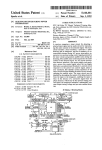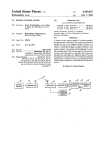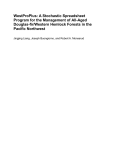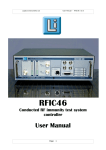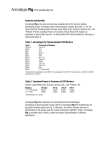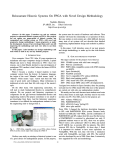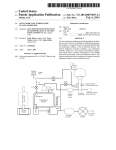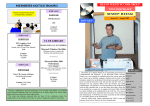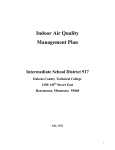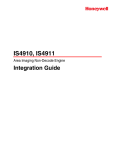Download Computer peripherals low-power
Transcript
US005821924A United States Patent [19] Kikinis et al. [54] [11] [45] COMPUTER PERIPHERALS LOW-POWER CONSUMPTION STANDBY SYSTEM [75] Inventors: Dan Kikinis, Saratoga; Pascal Dornier, Sunnyvale, both of Calif. Patent Number: Date of Patent: 5,821,924 *Oct. 13, 1998 OTHER PUBLICATIONS PC Computing, Oct. 1993, p. 297 Nanao USA Corporation. “One Watt after One Hour in One Year”, NUTEK, Feb. 1993, pp. 1—29. “Technical Information Datapoint Screensaver”, Datapoint, [73] Assignee: Elonex I.P. Holdings, Ltd., Great Britain Notice: The term of this patent shall not extend beyond the expiration date of Pat. No. 5,389,952. 1—4. “Department of Energy Efficiency”, NUTEK, Jun. 1992, pp. [21] Appl. No.: 548,662 Oct. 26, 1995 [22] Filed: 1—8. IBM Technical Disclosure Bulletin, “Increasing Lifetime and Reliability of CRT Displays”, vol. 34, No. 9; Feb. 1992, Related US. Application Data [63] Jan. 15, 1993, p. 1. NUTEK Speci?cation 803299/92—93, Dec. 3, 1992, pp. 1—2. “Installation Instruction ParC 100”, ParaCom, Nov. 5, 1992. “Environmental Labelling of Display Units”, Presented at the Third International Scienti?c Conference, Sep. 1992, pp. pp. 281—283. Continuation-in-part of Ser. No. 319,256, Oct. 6, 1994, abandoned, and Ser. No. 175,743, Dec. 30, 1993, Pat. No. 5,489,935, which is a continuation of Ser. No. 940,688, Sep. 4, 1992, Pat. No. 5,321,428, said Ser. No. 319,256, is a continuation of Ser. No. 141,413, Oct. 22, 1993, Pat. No. 5,389,952, which is a continuation of Ser. No. 984,370, Dec. “Auto turn—off monitors”, NUTEK, 1992, pp. 1—4. EDGE: Work—Group Computing Report, Mar. 18, 1991 v2 n43, p. 28(1) Notebook Displays . . . author Phoenix Technologies Ltd. ( Product Announcement). (List continued on next page.) 2, 1992, abandoned. Int. Cl.6 ............................ .. G09G 5/00; 6096 5/12; H04N 5/63 US. Cl. ........................ .. 345/212; 345/213; 348/730; 395/750.06 Field of Search ................................... .. 345/211—213; 348/730; 395/750, 750.01, 750.03, 750.05, 750.06; 364/707; H04N 5/63 Primary Examiner—Jeffrey Brier Attorney, Agent, or Firm—Donald R. Boys [57] ABSTRACT A system for loWering the poWer output of a computer peripheral device connected to a host computer during periods of inactivity of the host or the peripheral device senses a poWer management command at the peripheral References Cited U.S. PATENT DOCUMENTS 3,453,601 3,588,608 7/1969 Bogert et al. ...................... .. 340/1725 6/1971 Halinski et al. ........................ .. 317/31 (List continued on next page.) FOREIGN PATENT DOCUMENTS 0 444 997 488384 9/1991 6/1992 European Pat. Off. . European Pat. Off. . (List continued on next page.) device generated at the host computer. Time sensing means at the host senses inactivity, and gerating circuitry generates a power-management command. Detection circuitry in the peripheral device senses the power-management command, and controls poWer-using circuitry in the peripheral device in response. In an embodiment applicable to peripherals having a microprocessor, the system may be incorporated entirely in softWare at the host and the peripheral device. In dumb devices, the system requires add-in and/or add-on apparatus cooperating With softWare. 21 Claims, 9 Drawing Sheets 5,821,924 Page 2 U.S. PATENT DOCUMENTS 3,941,989 3/1976 McLaughlin et a1. ................ .. 235/156 4,338,623 7/1982 Asmus et a1. 4,404,500 9/1983 StoW ..... .. 3-105561 5/1991 Japan . 3-214871 3_238516 9/1991 1O/1991 Japan . Japan _ 358/22 4062614 2/1992 Japan _ . 315/386 4_O95146 3/1992 Japan _ Japan _ 4,488,181 12/1984 Heferl . . 358/220 4096811 3/1992 4,532,457 7/1985 Haferl . . 315/411 4_107623 4/1992 ]apan_ . 358/190 4_107624 4/1992 ]apan_ 4,553,166 11/1985 Sutton 4,649,373 4,667,289 4,722,005 3/1987 Bland et a1. 5/1987 Yoshida et a1. 1/1988 Ledenbach . 340/365 . 364/200 . 358/168 4440826 4_188972 4_195091 5/1992 7/1992 7/1992 Japan _ Japan _ Japan _ 4,751,502 4,806,784 6/1988 Ishii et a1. ............................. .. 340/709 2/1989 Goda ..................................... .. 307/125 4_20502O 4_245518 7/1992 9/1992 Japan _ Japan _ 4,823,121 4/1989 Sakamoto et a1. . 340/781 4_290388 1O/1992 Japan _ 4,922,448 5/1990 Kunieda et al. .. . 364/900 4344692 12/1992 Japan _ 4,980,836 5,021,983 12/1990 Carter et a1. 6/1991 Nguyen et a1. . 364/483 . 364/707 5_094163 9204394 4/1993 6/1992 Japan _ Rep of Korea _ 5,055,940 5,059,961 5,079,666 5,089,754 5,167,024 10/1991 Tomatsuri .. . 358/444 10/1991 Cheng ................................... .. 340/720 1/1992 Najm ....................................... .. 361/85 . 315/386 . 395/375 2264848 2265232 W0 89/O6012 W0 93/O7558 W0 93/124530 9/1993 9/1993 6/1989 4/1993 6/1993 United Kingdom _ United Kingdom _ WIPO _ WIPO _ WIPO _ 2/1992 George 11/1992 Smith et a1. 5,178,152 1/1993 . 128/680 WO 93/15495 8/1993 WIpO _ 5,226,122 7/1993 Thayer et a1. . OZaWa ..... .. . 395/275 W0 94/O6072 3/1994 WIPO _ 5,237,692 8/1993 Raasch et a1. . 395/725 5,245,312 9/1993 Kiuchi et a1. ...................... .. 340/309.4 5,315,311 5/1994 OTHER PUBLICATIONS Honkala .................................. .. 345/76 5,321,339 6/1994 Hunt ...... .. . 315/383 PC Week, Feb- 11, 1991 v8 n6, p- 5(1) PS/2 L40sx packs 5,335,168 8/1994 Walker . 364/707 design novelties . . . author Michael Caton. 5,369,771 11/ 1994 Gene} ------- ~- - 395/750 Paradise VGA Plus Card User’s Manual, 1988, Appendix D. 573757245 12/1994 Solhlell et al' - 395/750 IBM Personal System/2198 and Personal Computer BIOS 5’396’635 3/1995 Fung """""" " ' 395/800 Interface Technical Reference by IBM, 1987, pp. 4—59 to 5,423,045 6/1995 Kannan et a1. ....................... .. 395/750 4_61 and 4_121 to 4_125 5,430,881 7/1995 “ 574487262 9/1995 Lee et aL 5,457,801 Ikeda ..................................... .. _ 345/212 10/1995 Aihara ................................... .. 395/750 5,465,366 11/1995 Heineman ............................. .. 5,471,621 11/1995 Ohtsuki ---- -5,481,299 1/1996 Coffey et a1. . 534813732 1/1996 Shahbazl ' 5,483,464 395/750 1/1996 395/750 395/750 348/123 395/750 Song ..................................... .. 364/492 FOREIGN PATENT DOCUMENTS I _ ' _ _ 1’ Who s Using Your Electricity When Your Not There , NUTEK, PP- 1—8 Vesa Proposal; ‘PoWer Save’ Modez, Video Electronics Standards Association, 2150 North First Street, Suite 440, San Jose, CA 95131_202()_ “Monitors Sport Extra Features to Lure Users” InfoWorld Oct. 5, 1992, IDG Communications, Inc. (p. 397) Copyright 1992 (Abstract). “Nanao to Introduced LoW—Cost 15—inch WindoWs Moni 0 590 837 57-123598 60-090476 62-106523 62-216018 62-262250 62-276973 63-121365 63-261229 1257893 2-24696 2-053126 2-56620 2-280587 3-091798 4/1994 8/1982 5/1985 5/1987 9/1987 11/1987 12/1987 5/1988 10/1988 10/1989 1/1990 2/1990 2/1990 11/1990 4/1991 European Pat. Off. . Japan . Japan . tor” PC Week vol. 9. No. 42, Oct. 19, 1992, Ziff—Davis Publishing Company 1992 (p. 30) Copyright (Abstract). Japan . “Ecological PCs on the Way: Machine to Feature EPA Japan . Approval Stam” PC Week vol. 9, No. 48, Nov. 30, 1992, Japan . Ziff—Davis Publishing Company Japan . (Abstract). Japan . “EiZo Screen Turns on PoWer Saver When Not in Use” Japan . Computer Weekly Nov. 12, 1992, Reed Business Publishing Japan . Japan . Japan . 6) Copyright 1992 Group (p. 19) Copyright 1992 (Abstract). “Into the Station: Memorex Telex Release the 1477 CX Japan . Color Display Station and the 1236 Line Printer” MIDRANGE Systems vol. 5, No. 14 Jul. 21, 1992 Cardinal Japan . Business Media Inc. Japan . 57) Copyright 1992 (Abstract). U.S. Patent 0a. 13, 1998 <©> wEmO Km? / Sheet 4 0f 9 mmm 5,821,924 U.S. Patent 0a. 13, 1998 Sheet 6 of9 5,821,924 \\Em lm tlzolzI|l .9» m Dam \INF mEmO , <®>// U.S. Patent 0a. 13, 1998 Sheet 7 0f 9 5,821,924 @ .mm U.S. Patent 0a. 13, 1998 Fig. 7 Sheet 8 of9 5,821,924 U.S. Patent Oct. 13, 1998 Sheet 9 0f 9 5,821,924 Prlnt Request & Data 24 _/ ln Warm Up INIT 31 OFF i Check Fuser-Heater Status Turn Fuser Heater On ON 29 V Warm Up Period Accept Any Data To Print at Reduced Rate to Buffer until Fuser Heater is at Operating Temperature 37 4 DATA i Warm-Up Completed DATA Accept Data at 39 Maximum Rate Reset Set Trigger tWI = 0 Time tTRlG Monitor Period of Inactivity tW| = XX (time) tT RIG = YY (constant) 46 Set Fuser Heater at 2/3 Pwr tWl : 5 min. 48 tWI = 30 min. Set Fuser Heater at 1/3 Pwr tWI = 1 Hour Fig. 8 5,821,924 1 2 COMPUTER PERIPHERALS LOW-POWER CONSUMPTION STANDBY SYSTEM than do devices that have electrical heaters. In a typical Working environment, printers are left on all the time as a convenience to users and are consequently consuming poWer in order to keep the fuser-heater at the proper oper CROSS-REFERENCE TO RELATED DOCUMENTS ating temperature and the printer ready to print in response to instructions from a connected computer, ie a print This application is a Continuation-In-Part (CIP) of request. Aprint request sent by a computer is received by the printer buffer and scheduled for printing, Which typically copending application Ser. No. 08/319,256, ?led Oct. 6, 1994, noW abandoned, Which is a continuation of application Ser. No. 08/141,413, ?led Oct. 22, 1993, now US. Pat. No. 5,389,952, Which is a continuation of Ser. No. 07/984,370, ?led Dec. 2, 1992, abandoned. It is also a CIP of copending application Ser. No. 08/175,743, ?led Dec. 30, 1993, now US. Pat. No. 5,489,935 Which is a continuation of applica tion Ser. No. 07/940,688, ?led Sep. 4, 1992, now US. Pat. No. 5,321,428. All of these prior documents are incorporated commences When the buffer contains a full page and a “not 10 the main source of noise. If a printer is alloWed to run 15 herein by reference. FIELD OF THE INVENTION The present invention is in the ?eld of automatic poWer busy” message is received from the printer. The fuser-heater is the principal consumer of poWer in a laser-type printer and typically a fan for dissipating heat from the fuser-heater is 20 continually and no printing instructions are received, the fuser-heater Will be kept at a certain set temperature, the fan Will continue to operate to cool the rest of the printer, and the printer Will be in a ready state. If the printer is turned off When not being used, it Will require a certain amount of time to bring the fuser-heater up to a proper temperature and begin carrying out instructions from the computer When it is turned on again in response to a print command. The amount of time required for a fuser-heater to reach operating tem perature is dependent on several factors that are unique to saving methods and devices, and pertains in particular to reducing poWer consumption by computer peripheral devices. each printer. The Wait that is necessarily involved is aWk BACKGROUND OF THE INVENTION 25 PoWer consumption by computer peripheral devices, such as printers, display monitors, mass storage devices, and the like has become, With the expansion of computer installations, a signi?cant portion of residential and com mercial poWer requirements. For example, a typical color in an enclosed area, there may be a heat build-up that must 30 display monitor may consume as much as 50 to 80 percent Waste, electromagnetic radiation, high-energy radiation and 35 one or more of the connected peripheral devices isn’t needed. This might be determined by a period of inactivity on input devices such a modem, mouse and keyboard, 40 circuit or a program that displays moving images (or no image) to avoid burning the screen phosphors. Activating an emissions produced by some monitors. Thermal losses from ditioning equipment. The energy ef?ciency of display moni 45 tors has historically improved mostly as a result of advances in the electronic circuit components such as the increased use of integrated circuit (IC) devices. Cathode ray tube (CRT) technology has improved rather little in terms of energy efficiency. 50 peripheral device, such as a monitor or printer, or an add-on device for “dumb” peripherals, to shut doWn or restore some or all of the device’s electrical poWer circuits. One key to accomplishing this end is a means of signalling a monitor to shut doWn to some selected level Without adding to the sumers of electric poWer. The United States Environmental signals presently provided to a monitor. 55 SUMMARY OF THE INVENTION computer manufacturers to design for in neW systems. LoW-voltage IC’s use less energy, and microprocessor poWer management techniques alloW a computer to reduce energy consumption When idling. Until a suitable replace ment for the CRT or a more ef?cient CRT is developed it Will input device such as pressing a key or moving a mouse causes the previous screen image to be restored. This technique can be extended to reduce peripheral device poWer consumption by signalling a microcontroller in a The number of PCs in regular use is groWing rapidly and has reached a point Where they have become major con Protection Agency has issued poWer ef?ciency targets for inactivity of peripheral devices, monitoring of a computer’s internal bus, and in other Ways. Many computers and display terminals use such a technique to activate a screen blanking display monitors. Some people are annoyed by the acoustic display monitors contribute an additional load on air con consuming circuits in the display monitor, printers such as laser printers having fuser heaters, and in other peripheral devices, When the computer determines that full poWer on acoustic energy. Only the phosphor emissions are normally considered useful and then only When actively being Watched by an observer. The radiation emissions have been a hotly debated source of concern regarding possible health risks from long-term exposure. Manufacturers incur consid erable extra expense to reduce radiation emissions from be eliminated through climate control equipment to maintain a successful operation. If the principle heat-producing ele ment in a laser-type printer, the fuser-heater, could be turned off for times of non-use, this problem Would be considerably reduced. What is needed is a Way to shut doWn high-energy of the total electrical energy consumed by a personal com puter (PC). A display monitor dissipates this energy as visible light emissions from screen phosphors, thermal Ward and costly in a multi-user environment. With several computers and one or more printers running In a preferred embodiment of the invention, in a computer system having a host computer With a central processing unit (CPU), a memory, and input apparatus, and having also a 60 connected peripheral device, a poWer management system is be dif?cult to substantially improve personal computer energy efficiency. provided for managing poWer usage by the peripheral device, comprising a timer for detecting periods of inactivity As described above, display monitors are not the only computer peripheral devices Which consume large amounts at the computer; a signal generator for generating poWer management commands for the peripheral device; and a poWer manager circuit in the peripheral device. After pas sage of a pre-stored time period of inactivity of the host computer, the timer signals the signal generator to send a of energy in use. Laser printers are another example. Other 65 peripherals, such as mass storage devices, also consume electrical energy When not in full use, but to a lessed extent 5,821,924 3 4 power management command to the peripheral device, and distinct signals to a monitor to signal the monitor to adjust the poWer manager circuit in the peripheral device causes the peripheral device to assume a reduced-poWer state other than off in response to the poWer management command. to as many as three states. In an embodiment of the Speci?c embodiments manage poWer for such as display monitors and printers having fuser heaters, as these devices interrupting one or the other or both HSYNC and VSYNC invention, the states are selected levels of monitor poWer management (MPM). The signal to the monitor is based on signals. In the embodiment shoWn in FIG. 1 a PC 111 comprises a Basic Input Output System (BIOS) 113 and a Video Graphics Adapter (VGA) 117. The invention Will Work equally Well With other video adapters, as virtually all such adapters employ HSYNC and VSYNC signals. In some other adapters, equivalent means of interrupting the HSYNC and VSYNC signals Would be used. use excess poWer by virtue of heating apparatus. In some embodiments reduced-poWer states are delayed after a com mand. A computer is provided comprising a central processing unit (CPU), a memory connected to the CPU for storing data and instruction routines, input apparatus coupled to the CPU for a user to provide input to the computer, a timer for detecting periods of inactivity of the computer, and a signal generator adapted for sending a poWer management com mand to a peripheral device. In this embodiment the timer, in response to passage of a pre-stored period of inactivity of the computer, signals the signal generator to send the poWer 15 management command to the peripheral device to assume a ments instructions for implementing MPM might be embed ded in operating system (OS) device driver routines or Terminate and Stay Resident (TSR) programs. The MPM instructions monitor CPU 115 interrupts for input devices (not shoWn) such as the timer, keyboard and reduced-poWer state other than off. In one alternative signals are sent to a peripheral device by disabling one or more signals typically sent. The pattern of disabled signals pro vides a unique command. Control routines for poWer management in embodiments of the present invention may reside in any one of several BIOS 113 includes instructions for MPM, Which can cause a central processing unit (CPU) 115 to change the state of sync-enable controls in VGA 117. In alternative embodi 25 serial communication ports. MPM instructions advance a time-out counter on each timer interrupt and reset the count to an initial value on each monitored interrupt. The initial value of the MPM time-out counter may be ?xed or adjust able. When the MPM time-out counter reaches a preset over?oW value, due to cessation of monitored interrupts, locations. Such control routines may be a part of a BIOS or instructions are executed that change the state of HSYNC Enable 124 and VSYNC Enable 126 control to disable of an operating system, for example. In some embodiments, apparatus for enabling poWer management is provided as an add-in (expansion card) or by output of horiZontal synchroniZation signals (HSYNC) 123, produced by horiZontal sync generator 122, and/or vertical add-on apparatus. In many embodiments several different synchroniZation signals (VSYNC) 125, produced by vertical signals may be sent, corresponding to different activity sync generator 120, or both. A subsequent monitored inter rupt causes execution of instructions that change the state of HSYNC Enable 124 and VSYNC Enable 126 control cir cuits to enable output of HSYNC 123 and VSYNC 125 signals from VGA 117. criteria, and different poWer levels are provided in response to the different commands. BRIEF DESCRIPTION OF THE DRAWINGS FIG. 1 is a largely schematic representation of a PC according to an embodiment of the present invention. FIG. 2A is a largely schematic representation of a PC enhanced by an add-on device according to an alternative embodiment of the present invention. FIG. 2B is a largely schematic representation of a PC enhanced by an add-in device according to another alterna tive embodiment. FIG. 3 is a largely schematic representation of a microcontroller-based video monitor according to an embodiment of the present invention. FIG. 4 is a largely schematic representation of a “dumb” monitor equipped With an add-in device according to an alternative embodiment of the present invention. FIG. 5 is a largely schematic representation of an add-on device for controlling AC primary poWer to a monitor according to another alternative embodiment of the present invention. FIG. 6 is a vieW of a laser-type printer as used With the 35 In the case of a VGA controller, the enable/disable capa bility is through Writing by the CPU into register 3C2 of the controller, Wherein bits six and 7 are reserved for horiZontal retrace polarity and vertical retrace polarity respectfully. HSYNC and VSYNC signals 123 and 125 are brought to interface 121 along With other signals, such as R, G, and B signals from D/A/converter 119. The signals are transmitted to a monitor on VGA cable 127 as is knoWn in the art. The 45 Reference, published by IBM in 1987. In an alternative embodiment, shoWn in FIG. 2A, useful for re?tting existing computers, a current art PC 211 having a CPU 215 is enhanced by installation of a sWitch 231, Which connects betWeen a VGA217 VSYNC output 225 and VSYNC input 226 to a video interface 221. In a color 55 present invention. FIG. 7 is a draWing of a laser-type printer operated causes instructions to be executed Which change the state of according to the present invention on a netWork With several FIG. 8 is a How chart of the printing process according to the present invention. FIG. 1 shoWs the functional elements of a preferred embodiment of the present invention capable of providing 3 computer, R,G, and B signals are brought to interface 221 from DAC 219. An add-in time-out controller 229 compris ing MPM instructions monitors input device activity as described above for FIG. 1. Time-out of all input devices program-controlled sWitch 231, blocking VSYNC input 225 computers. DESCRIPTION OF THE PREFERRED EMBODIMENTS pin-out for the signals on a VGA cable is Well-known, and is shoWn in IBM Personal System/2, Model 80 Technical 65 to video interface 221. Resumption of monitored interrupts causes sWitch 231 to close, returning the VSYNC signals to line 226. A second sWitch 232 may be used in the HSYNC line to interrupt the HSYNC signals to line 224, and, in this embodiment, the add-in time-out controller controls both sWitches. In yet another alternative, one sWitch may be used to interrupt both HSYNC and VSYNC signals. The functional blocks presented in FIG. 2A are an internal solution to an add-in hardWare/softWare embodiment, and 5,821,924 5 6 the blocks are not intended to be taken literally as hardware devices and interfaces. It Will be apparent to one With skill in the art that there are many equivalent Ways the functional Without a microcontroller. A sync detect circuit 451 com pares pulse intervals for HSYNC 435 and VSYNC 437 against time-constants of adequate duration to alloW for brief interruptions of sync pulses. Loss of HSYNC 435 blocks might be accomplished. The keyboard, mouse, and modem inputs are monitored by the add-in controller, and pulses or VSYNC 437 pulses for periods longer than the associated time-constants causes sync detector circuit 451 to are made available as Well to the CPU in the typical manner. FIG. 2B shoWs an external solution for a hardWare/ softWare embodiment. In this solution an add-on time-out controller 259 is external to computer system 233, and each port that supports an input device and the video output port change Level-1 signal line 441 or Level-2 signal line 443 voltage to its active state as described for FIG. 3 and With the 10 is ?tted With an interface device connected to the add-on time-out controller. For example, interface 243 at COM port 241 used for a modem 245 monitors modem activity and reports to controller 259 on line 244. Interface 249 at keyboard port 247 monitors keyboard 251 activity and 15 external enclosure having pass-through connections, inserts into VGA cable 127. Sync detect circuit 551 monitors video signals on VGA cable 127 and compares the SYNC interval reports to controller 259 on line 250. Interface 255 at pointer port 253 monitors pointer 257 activity (mouse, joystick, for one or the other of VSYNC and HSYNC to a time constant in a manner similar to that described for FIG. 4 trackball), and reports to controller 259 on line 256. In this embodiment controller 259 accomplishes the timer functions and outputs signals on line 238 to interface device 237 at video port 235. Line 239 goes to the monitor. Device above. Loss of the monitored SYNC signal in VGA cable 127 for an interval longer than the time-constant causes sync detect circuit 551 to change the voltage on poWer-control 237 interrupts HSYNC and VSYNC signals according to the over?oW states of add-on controller 259. Acolor video monitor 347 according to an embodiment of the present invention is shoWn in FIG. 3. Monitor 347 comprises an interface 333, a microcontroller 339 having MPM instructions according to the present invention and a same results. Similarly, resumption of HSYNC 435 and VSYNC 437 pulses reactivates monitor 447 as described for FIG. 3 above. FIG. 5 shoWs another alternative embodiment of the present invention suitable for add-on use With a monitor 547 having an interface 533. A sync detect circuit 551, in an line 561 to its active level, Which in turn causes an electronically-controlled sWitch 553 to open. Electronically 25 controlled sWitch 553 controls AC primary poWer from an electrical cord 559 to a receptacle for monitor 547 poWer supply cord 557. When electronically-controlled sWitch 553 opens, AC poWer to a DC poWer supply 555 is lost, thus video circuit (VC) 345 having voltage control circuitry. causing total shutdoWn of monitor 547. Resumption of From interface 333 HSYNC pulses 335 and VSYNC pulses SYNC signals in VGA cable 127 video signal causes sync detect circuit 551 to change poWer-control line 561 to its 337 go to microcontroller 339. Microcontroller 339 moni tors the HSYNC signal 335 and VSYNC signal 337. The quiescent state, thus causing electronically-controlled MPM instructions described above count the number of sWitch 553 to close, Which restores AC poWer input to DC HSYNC pulses occurring betWeen each pair of VSYNC pulses. Zero HSYNC pulses counted causes the MPM instructions in microcontroller 339 to change the voltage on Level-2 signal line 343. Similarly, an interval count of HSYNC 335 pulses greatly in excess of the maximum video scan rate for monitor 347, indicating a loss of VSYNC 337, causes microcontroller 339 to change the voltage on Level-1 signal line 341. Resumption of HSYNC 335 to VSYNC 337 poWer supply 555 reactivating monitor 547. 35 described, such as MPM instructions implemented in an OS device driver or TSR routines instead of the BIOS, single level MPM instead of tWo-level MPM and an external video pulse interval counts to a range from the minimum to the maximum scan rate causes MPM instructions in microcon troller 339 to restore quiescent voltage levels to Level-1 signal line 341 and Level-2 signal line 343. It Will be apparent to one With skill in the art that there are many changes that might be made in the embodiments describing poWer-management of display monitors and the like Without departing from the spirit and scope of the invention. Some of these alternatives have already been 45 When video circuit 345 senses an active voltage level on Level-1 signal line 341, it cuts off poWer to all circuits in monitor 347 except microcontroller 339, any poWer neces sary to interface 333, and video circuit 345 poWer-control circuits (not shoWn). In this level 1 standby mode, poWer consumption of monitor 347 is reduced by more than 90 percent. If monitor 347 remains in level 1 standby for more than a feW seconds, full Warm-up time is required to reactivate it. An active voltage level on Level-2 signal line monitor poWer control device. Other methods of signalling MPM state changes to a monitor might include time-based coded sequences of frequency changes in HSYNC or VSYNC, coded values in the color signals, or no color signal for an extended period. Alternative embodiments of MPM routines might alloW an operator to control MPM operation through command steps, such as menus, dialog boxes or command lines. Such controls might include shutting doWn monitor poWer at Will by pressing a “hot key”, typing a command line or other program interface step. Other fea 5 seconds or less. Reactivation of monitor 347 occurs When tures might alloW the operator to change the idle time required to trigger MPM and toggle MPM monitoring on or off. Alternative MPM routines might also require an operator to type a passWord before enabling the transmission of normal video signals to the video monitor. Alternative devices for both built-in and post-manufacture modi?cation to implement monitor poWer control might be devised. Embodiments of the present invention for monochromatic voltage on Level-1 signal line 341 and Level-2 signal line 343 returns to the quiescent state alloWing video circuit 345 templated. 343 causes video circuit 345 to cut off poWer to all circuits 55 except those described above plus the CRT cathode heater. In level 2 standby mode monitor 347 poWer consumption is reduced by 80 to 90 percent. Because the CRT is kept hot, reactivating monitor 347 from level 2 standby requires about and grey-scale video adapters and monitors are also con to activate poWer to all circuits of monitor 347. As described above, display monitors are not the only FIG. 4 shoWs an alternative embodiment of the present computer peripheral devices Which consume large amounts invention in a monitor 447 With video circuits functionally 65 of energy While is a resting condition. Laser printers, and similar to those described for the monitor shoWn in FIG. 3, other printers that use fusing processing requiring heat are another example. including an interface 433 and a video circuit 445, but 5,821,924 8 7 performs this function automatically. In a preferred mode of operation the reduced data acceptance rate is set to be equal FIG. 6 is an isometric drawing of a laser-type printer 1013 operable according to the present invention, and Which contains a fuser-heater 1015, a drum 1016, a fan 1018, a buffer 1020, a controller 1022, and a cable connection 1023 that joins the printer to a host computer or a to a netWork. to or smaller than the buffer siZe divided by the Warm-up time. In some embodiments the control routines can further be manipulated to manually turn the fuser-heater on or off at any time. Fuser-heater 1015 is responsible for heating the toner applied to drum 1016 after an image has been Written to the FIG. 8 is a flow diagram illustrating the operation of the present invention to control laser-type printer functions and drum to fuse the toner to the paper. Instructions sent by a computer What is Written, and the entire process is managed by control routines. Fan 1018 (if used) in the printer is poWered on at start up and is usually controlled by a heat-sensing mechanism that reacts to internal temperature and runs in reaction to cool mechanical and electronic elements of the printer. The majority of printers have a memory buffer that electronically stores composed pages transmitted by the control routines and sends the data to the processing unit of the printer as the printer is ready to accept it. When the buffer has emptied its contents to the printer and all instructions from the computer have been carried out, the printer Waits for further input and maintains all of its thereby save poWer and decrease noise. 10 An INIT signal (point 1026) is received from a host system When the system starts up, such as after an inten tional doWntime. INIT turns on fuser-heater 1015 at point 1031 as a consequence of turning on the printer itself. The INIT signal or similar signal is also received When a 15 laser-type printer is turned on directly. After start-up, the system responds to print requests from the server 1027 or any one of the computers 1025 on the netWork (FIG. 7). The system receives a print request at point 1024 and determines Whether the fuser-heater is on, off, or in a Warm-up mode (point 1029). components in a state of readiness. Actual operation can vary from printer to printer according to the type and speed If the fuser-heater is on and at operating temperature When of the printer and the siZe of the printer buffer. It is not the intent of the present description to present a detailed descrip tion of laser-type printing, but rather to present an eXample of a relatively common printing function and demonstrate its functional components in the context of the present inven tion. a print request is received, data is accepted by the buffer at maXimum rate (1037). The rate for a particular printer buffer 25 is unique to each laser-type printer. The printer fuser-heater is managed by monitoring the time betWeen print requests (1041). This time is designated FIG. 7 demonstrates laser-type printer 1013 operating Within tWI, for time Without input, and is measured by a timer in the control circuitry. The timer is reset to Zero (1043) each time a print request is received and the printer is determined to be a netWorked environment of other computers 1025 and possibly other printers and With a netWork server computer 1027. The present invention provides a means to keep the initialiZed and at operating temperature. A trigger time, TTRIG, is set (1039) for a maXimum period betWeen print requests, and the fuser-heater is shut off (1045) When The embodiment of the present invention as shoWn in tW,=tTR,G. In some embodiments the trigger time may be set printer operating and prepared to print but to save poWer by turning off the fuser-heater portion of the laser-type printer. 35 In response to a reduction in heat created by turning off the fuser-heater, the fan Will shut doWn and run only infrequently, if at all, in response to ambient heat from other sources. The connection to a computer or computers is never broken. The turning off of the fuser-heater signi?cantly lessens poWer consumption and heat dissipation require ments. Control routines that are a part of the invention can be installed on any computer that uses a printer that uses a 45 fuser-heater or can be installed solely on netWork server, If, When a print request is received, the fuser-heater is in a Warm-up mode (1035), data from a print request is accepted at a sloWer rate than the maXimum data transfer rate available. Data is accepted at the maXimum rate after the fuser-heater is at operating temperature. If When a print request is received the fuser-heater is off, the control system turns it on (1031), putting the fuser-heater in Warm-up mode, and the printer buffer accepts data more sloWly until the fuser-heater is at operating temperature. The amount of time it takes for the fuser-heater to Warm up is dependent upon the particular printer, and can vary. Additional contributing factors to the length of Warm-up time include the difference betWeen a printer being poWered on after an intentional doWntime, in Which the length of time it takes to Warm up is naturally greater, and the case When a print request has such as server 1027 in FIG. 7, or may be installed preferably in the printer. The system of the invention comprises a means of turning off fuser-heater 1015 (FIG. 6) in laser-type printer 1013 after a set amount of time has passed Without any input from the netWork server or from the connected computer or computers, and to turn it back on again When the connection is initialiZed (such as When a computer on the netWork is turned on) or a print request is sent from an attached netWork server or single computer. The printer stays on all the time, and only the fuser-heater element is turned off. When the fuser-heater is turned back on after being poWered doWn, it requires a certain amount of time to reach in the softWare and not accessible as a variable to a user. been handled only moments before, requiring only a short Warm-up. In an alternative, and someWhat more sophisticated embodiment of the invention, there is more than one trigger 55 time, and the fuser-heater is only partially shut doWn in some instances. For example, the control routines may be Written and hardWare included in a printer, so the fuser-heater, after a ?rst period of 5 minutes, Would be reduced to 2/3 poWer. If no print request is received after 30 minutes, the poWer Would be reduced to 1/3, and if no request is received after 1 hour, the poWer Would be shut off. the correct operating temperature. During this time, the printer buffer is fully active and still accepts input but does so more sloWly than usual until the fuser-heater is at This embodiment addresses the possible reasons for no operating temperature. This sloWer data acceptance rate avoids softWare timeouts, such as might occur When printing from DOS. Auser Will seldom notice sloWer operation and print requests. The 5 minute trigger addresses the ongoing Will not be aWare that an element in the printer has been turned off or conversely, turned back on again. The system 65 situation that assumes that the users have only periodic need for the printer, and alloWs for rapid Warm up When a neW request is received. The 30 minute trigger anticipates situ ations like lunch time and shift change, and still alloWs for 5,821,924 10 a shorter Warm up than a complete shut doWn. The one hour erator comprises the CPU signaling an adapter to disable one trigger anticipates everyone has gone home for the day or the Weekend, and shuts off the poWer completely. In this embodiment, the times may be adjusted empiri cally to provide the minimum poWer usage for the demand pattern of a particular organiZation, and in other embodi of several signals provided by the adapter for communicat ing With the peripheral device. 6. A computer as in claim 5 Wherein the control routines are provided in a basic input output system (BIOS) in a programmable read-only memory. 7. A computer as in claim 4 Wherein the timer and the signal generator are parts of an add-in time-out controller ments more or feWer trigger times might be useful. It Will be apparent to one With skill in the art that there are a number of changes that may be made to the embodiments of the invention described herein Without departing from the spirit and scope of the invention. One of these is the fact that the invention is not limited to any particular computer, 10 pointer device, and the timer and the signal generator are device. Computers or printer With fuser-heaters of any manufacture can be used providing control routines are 15 Written in the languages that the computers and printers parts of an add-on time-out controller, Wherein the timer is connected to sensing devices interfaced at input ports for the input apparatus, and the signal generator is interfaced to a port providing signals for communicating With the periph require. The present invention can also be used to control several printers that are connected together into a netWork, and still alloW manual operation of any one of the printers. eral device. 9. A computer peripheral device having a port for signals for communicating With a host computer, comprising: a receiver adapted for receiving a poWer-management The invention is broadly applicable to any system using printers that have fuser-heaters, as Well as to display command; and monitors, mass storage devices, and other peripheral a poWer manager circuit; Wherein the receiver sends a command to the poWer devices.. It is seen, then, that there are many alterations that 25 manager circuit on receiving the poWer-management command, and the poWer manager circuit reduces poWer to poWer-using circuitry in the peripheral device to an intermediate level other than off in response to the command from the receiver. 10. A computer peripheral device as in claim 9 Wherein central processing unit (CPU), a memory, and input apparatus, and having also a connected peripheral device, a poWer management system for managing poWer usage by the receiver is adapted for receiving and discriminating among different poWer-management commands. 11. A computer peripheral device as in claim 10 Wherein the peripheral device, comprising: a timer for detecting periods of inactivity at the computer; a signal generator for generating power-management commands for the peripheral device; and a poWer manager circuit in the peripheral device; Wherein, after passage of a pre-stored time period of 8. A computer as in claim 4 Wherein the input apparatus comprises one or more of a keyboard, a modem, and a netWork server, printer, display monitor, or other peripheral may be made Without departing from the spirit and scope of the invention. What is claimed is: 1. In a computer system having a host computer With a adaptable to an eXisting computer by connecting to eXisting signal lines of the computer. 35 inactivity of the host computer, the timer signals the the poWer manager reduces poWer to different reduced poWer levels in response to the different poWer-management commands. 12. Amethod for saving poWer in operation of a computer system Wherein a host computer sends signals to a peripheral device, comprising steps of: (a) sensing periods of inactivity of the host computer; signal generator to send a poWer management com mand to the peripheral device, and the poWer manager circuit in the peripheral device causes the peripheral (b) sending a poWer-management command to the periph device to assume a reduced-poWer state other than off host computer; (c) detecting the poWer-management command at the in response to the poWer management command. 2. ApoWer management system as in claim 1 Wherein the peripheral device is one of a printer having a fuser heater and a display monitor. 3. ApoWer-management system as in claim 1 Wherein the peripheral device has a ?lament heater, and poWer is reduced but not suspended to the ?lament heater in one of the eral device in response to a period of inactivity of the 45 eral device from the detection circuitry that a poWer management command is received; and (e) reducing poWer to poWer-using circuitry in the periph eral device to a level other than off by the poWer reduced-poWer states. 4. A computer comprising: a central processing unit (CPU); management circuitry in response to the signal from the detection circuitry. 13. The method of claim 12 Wherein in the reducing a memory connected to the CPU for storing data and poWer step, poWer is reduced but not suspended to a ?lament instruction routines; input apparatus coupled to the CPU for a user to provide peripheral device by detection circuitry; (d) signaling poWer-management circuitry in the periph 55 heater in the display monitor. 14. The method of claim 12 Wherein in the reducing input to the computer; a timer for detecting periods of inactivity of the computer; poWer step poWer is suspended to a ?lament heater in the and a signal generator adapted for sending a poWer manage ment command to a peripheral device; Wherein the timer, in response to passage of a pre-stored poWer-management commands are sent according to differ peripheral device. 15. The method of claim 12 Wherein, in step (b), different ent periods of inactivity in step (a). 16. The method of claim 15 Wherein alternative distinct reduced-poWer states are provided according to the different period of inactivity of the computer, signals the signal periods of inactivity. generator to send the poWer management command to the peripheral device to assume a reduced-poWer state other than off. 5. A computer as in claim 4 Wherein the timer comprises control routines eXecuted by the CPU, and the signal gen 65 17. In a computer having circuitry providing signals to a peripheral device, a method for signaling the peripheral device to assume alternative poWer-using states, comprising steps of: 5,821,924 11 (a) detecting different periods of inactivity of the com puter; and (b) sending power management commands to the periph eral device to assume alternative power states in response to detecting the different periods of inactivity of the computer. 18. A method for directing assumption of an alternative poWer-using state in a computer peripheral device, compris ing steps of: detecting a poWer-management command sent to the peripheral device from a host computer; and signaling poWer-management circuitry in the peripheral device to assume an intermediate poWer level other than off in response to the poWer-management com mand. 19. The method of claim 18 Wherein different poWer management commands are detected and alternative differ ent poWer levels are assumed in response. 20. A computer peripheral device comprising: a detector adapted for detecting a poWer management command conveyed to said peripheral device by a host computer; and 12 poWer level control circuitry responsive to said detector for managing poWer-using circuitry in said peripheral device; Wherein said detector detects said poWer management command, and said poWer level control circuitry pro vides in response tWo reduced-poWer states for said peripheral device, one of the reduced-poWer states delayed for a predetermined period of time after the initiation of the other reduced-poWer state. 21. A computer peripheral device having a cathode ?la ment and a ?lament heater, comprising: a detector adapted for detecting a poWer management command conveyed to said peripheral device by a host computer; and poWer level control circuitry responsive to said detector for managing poWer-using circuitry in said peripheral device; Wherein said detector detects said poWer management command, and said poWer level control circuitry pro vides in response an intermediate reduced-poWer state Wherein the ?lament heater is on.

















